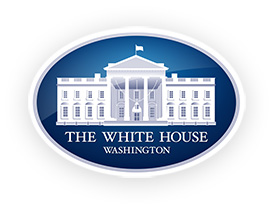It's an important day in American history (or, at least, in American cinematic history):
It's the date to which Marty McFly traveled into the "future" in Back to the Future Part II.
We've come a long way in the 30 years that have passed since the original Back to the Future came out. Now, we're going to talk about where we're going in the next 30.
All day long, we're hosting a series of conversations with scientists and innovators across the government and the country. You'll be able to ask them questions, watch videos explaining their cutting-edge developments, and share your answer to the question above: What does 2045 look like?
Here's the schedule for the day.
(Remember -- we'll be posting all kinds of great stuff over the course of the day, so check back frequently!)
9:30 a.m. ET: A Google+ Hangout Conversation on Time Travel
Featuring: OSTP Deputy Director for Technology and Innovation Tom Kalil, Professor Tim Ralph of the University of Queensland in Brisbane, Australia, and Mr. Martin Ringbauer, a PhD student at the University of Queensland.
What you can do: Watch live right here!
10:30 a.m. ET: A Twitter Conversation on Autonomous Vehicles
Featuring: Deputy Chief Technology Officer Ed Felten, and Special Assistant to the President for Economic and Technology Policy R. David Edelman.
What you can do: Follow @EdFelten44 and @WhiteHouseOSTP -- and weigh in on the conversation on Twitter using #BackToTheFutureDay.
11:30 a.m. ET: A Twitter Q+A on the Future of Women in STEM
Featuring: Chief Technology Officer Megan Smith, NASA Chief Scientist Dr. Ellen Stofan, OSTP Principal Assistant Director for Environment and Energy Tammy Dickinson, and L'Oréal's 2015 U.S. Women in Science fellows.
What you can do: Follow @USCTO and @LOrealUSA on Twitter, and weigh in on what you'd like to see women doing in STEM fields in 2045 using hashtag #WomenInScience.
1:00 p.m. ET: A Google+ Hangout on Understanding the Human Brain
Featuring: OSTP Assistant Director for Neuroscience and Mental Health Monica Basco; OSTP Senior Policy Advisor Knatokie Ford; OSTP Assistant Director for Defense Programs (and neuroscientist) Chris Fall; Karl Deisseroth M.D., Ph.D., the D.H. Professor of Bioengineering and of Psychiatry and Behavioral Sciences at Stanford University; Kevin Pearce, Snowboarder and BRAIN initiative activist; and Dr. Julie Brefczynksi-Lewis, Research Assistant Professor at the West Virginia University School of Medicine.
What you can do: Watch live right here.
Get excited, and remember: Where we're going, we don't need roads.
(Just kidding. We definitely do. And by the way, Congress should fund them.)
Michael J. Fox just sent this message to the White House list. (Didn't get it? Get on the list here.)

We’ve come a long way since 1985.
When Marty McFly and Doc Brown traveled 30 years into the future, we could only imagine the innovations we take for granted today -- new ideas and technologies that have completely changed the way we live, learn, and work.
Back then, if you’d have told me that I’d go from talking on a cell phone to talking cell biology, I would never have believed you. But today, The Michael J. Fox Foundation is helping to spearhead research collaborations to speed a future in which we can treat, cure, and even prevent brain diseases like Parkinson's.
So what’s possible in another 30 years? Call me an optimist, but I believe that by 2045 we’ll find the cures we seek -- especially because of all the smart, passionate people working to make it happen. Doctors and researchers around the world are developing new tools to improve the diagnosis and treatment of brain diseases, to tailor treatments -- for all illnesses -- through precision medicine, and to make life better for millions of people. This truly is the stuff of the future.
Today, on “Back to the Future Day,” I challenge you to imagine the world you want to live in thirty years from now. The White House is hosting a series of online conversations with innovators across the country all day long. Check it out and add your voice here.
We can't all be brain scientists, but all of us can get involved. One reason Parkinson’s research has come so far in the past 15 years is that people and families living with the disease have stepped up as advocates and innovators themselves, working to build the future we all want.
Together, we’ll make neurological illness a thing of the past.
And if we all eventually get hoverboards, well -- that's a bonus.
--Michael J. Fox
Worth a follow: the nasa tumblr is highlighting modern technologies they couldn't have dreamed of in 1985.
It’s #BackToTheFuture Day! What would a time traveler from 1985 discover about NASA today? https://t.co/Qc8katwzlr pic.twitter.com/0M3cPafbQJ
— NASA (@NASA) October 21, 2015
file under "things that happen in 2015:" legitimate conversations about self-driving vehicles.
And we don't have to go #backtothefuture to see this technology in action; it's here, being tested, today. https://t.co/k1Gv0lLjsd
— The White House OSTP (@whitehouseostp) October 21, 2015
and let's not forget that time the president of the united states got 3d-printed.
Go behind the scenes at the White House and watch how it was done.
in which NASA Chief Scientist Dr. Ellen Stofan tells you exactly how we can get more women into stem fields:
They need role models, they need the history of women in science and technology, and they need ENCOURAGEMENT! https://t.co/VAA9509O4a
— Ellen Stofan (@EllenStofan) October 21, 2015
you told us: here's what 2045 looks like.
All day long, as you share your predictions for 30 years into the future, we'll be highlighting what we hear from you.
"Our transportation infrastructure evolves to a system of Solar Panel Pavements (SPP) that not only provides emission free and efficient energy for everyone, but can also power and facilitate navigation that will eliminate traffic issues and improve safety.”
"Every citizen will have access to nutrition education from 1 grade thru 12, and in college it will continue for those choosing to work in the field of nutrition, food safety, and healthcare. Health care services will be provided by professionals with extensive background training in food physics as it relates to wellness. Crops will be grown within cities, in small urban farms. People will know how to select, handle, store and prepare foods safely and with flavorful nutrients to support wellness and longevity.”
"In the same way that access to video games and PCs opened up whole new creative fields in design and animation, I think our relatively new access to mobile Internet will change the way education is done 30 years from now. Things like purely informational lectures will become less and less necessary at school as places like YouTube and Coursera provide higher quality and more comprehensive lectures. I think that's good for traditional institutions, as teachers will have more freedom to spend classtime on discussions and projects, growing students' ability to apply their knowledge. Of course, this can only happen if students get their homework done :p”
WHEN IT COMES TO THE FUTURE, THE DEFENSE ADVANCED RESEARCH PROJECTS AGENCY (DARPA) IS basically already working on it. meet THREE DARPA PROGRAM MANAGERS, and their (VERY POSSIBLE) VISIONS FOR 2045:
Dr. Justin Sanchez, Neurotechnologist and DARPA Program manager
Dr. Stefanie Tompkins, Director of DARPA'S Defense Sciences Office
pamela melroy, deputy director of darpa's tactical technology office
worth a read -- our newly released strategy for american innovation (think about what they would have said in 1985!)
Here's a post from Tom Kalil -- Deputy Director for Policy for the White House Office of Science and Technology Policy and Senior Advisor for Science, Technology and Innovation for the National Economic Council -- about how what we used to consider "science fiction" is rapidly becoming fact.
Make sure you don't miss this very important piece:
While today's been full of predictions and cutting-edge ideas about our future, it also marks the release of the President's updated Strategy for American Innovation -- basically, a roadmap of the Administration's efforts to make sure that America continues to develop world-changing innovations for years to come.
Mining asteroids for rocket propellant: This is the potential future of space exploration.
As we look 30 years into the future for space exploration, and as we prepare to meet the President’s goal of sending a human mission to Mars in the 2030s, one technical challenge that NASA is working hard to solve is how to make it so that the bulk of the mass we use in space and space exploration does not have to be sent up in a rocket from Earth, but rather can be sourced "in-situ” in space. These approaches will allow us to, as the President mentioned in his 2015 State of the Union address, push out “into the Solar System not just to visit, but to stay.”
To that end, NASA is already working on printable spacecraft, automated robotic construction using regolith, and self-replicating large structures. As a stepping stone to in-space manufacturing, NASA has sent the first-ever 3D printer to the International Space Station. One day, astronauts may be able to print replacement parts on long-distance missions. And building upon the success of the Mars Curiosity rover, the next rover to Mars — currently dubbed Mars 2020 — will demonstrate In-Situ Resource Utilization on the Red Planet. It will convert the carbon dioxide available in Mars’ atmosphere to oxygen that could be used for fuel and air — all things that future humans on Mars could put to use.
These efforts excite not just the Federal government, but the American public as well. For example, NASA is engaging innovators and entrepreneurs through its NASA Innovative Advanced Concepts (NIAC) Program, which funds research that nurtures visionary ideas and could create breakthroughs in technology to help future NASA missions.

We spoke with one of the NIAC grant recipients, Dr. Joel Sercel, about the potential for in-space asteroid mining for the future of space exploration:
How does your work support the President’s vision in space?
There are millions of tons of valuable resources in asteroids that are far easier to get to than the surface of the Moon or Mars. These are the stepping stones to the future of humanity in space. The Asteroid Provided In-Situ Supplies (APIS) system is an approach to affordably extract rocket propellant and other vital commodities from the asteroids to avoid the high cost of launching these materials from the Earth.
How can we mine rocket propellant from an asteroid in space?
Our team has developed an optical mining process that uses highly concentrated sunlight to break up the asteroid and force it to release volatile chemicals like water and carbon dioxide, which can be the ingredients for rocket propellant. We collect these materials in special lightweight bags as ice through a process called passive thermal cryopumping. We can use water directly as propellant in our solar thermal rocket engines and we can also use it for radiation shielding, as drinkable water for astronauts, or to make oxygen for breathable air.
What possibilities does successful asteroid mining open up for space exploration?
At first, our optical mining process will be used to supply propellant for a small fleet of low-cost, reusable space tugs. Space tugs will be commercial carrier vehicles that NASA can hire to carry astronauts on missions of exploration at vastly reduced costs. This will enable affordable human exploration of Mars in the short term. Space tugs will also carry commercial and government spacecraft to destinations such as Geostationary Earth Orbit (GEO), vastly reducing the cost of space operations for both the government and private sector. Next, space tugs will help enable the mining industry to extract precious metals from asteroids and return them to Earth. Commercial asteroid mining can provide the economies of scale to enable large scale space tourism in deep space and in-space manufacturing of many types of products. The key will be to develop the technology for solar-powered robotic factories supplied by asteroid materials. Our vision aligns with the President’s vision in seeking to move manufacturing off the surface of the Earth and make it possible for people to build and live in colonies in space.
Dr. Sercel is just one of many examples of American space entrepreneurs working to solve our current challenges in space travel and create the future of space exploration.
Know of others or have ideas for massless exploration and supercharging space exploration through 2045? Send your ideas for how the Administration, the private sector, philanthropists, the research community, and storytellers can further these goals to massless@ostp.gov.
Meanwhile, back at the ranch, a team of researchers are working on a real-life invisibility cloak. (really.)
The President’s newly released Strategy for American Innovation articulates the importance of investing in industries of the future, such as nanotechnology and advanced materials. As we celebrate the release of the Strategy, we are looking at new innovations and emerging technologies that Federal funding supports and have the potential to shape our world 30 years into the future.
One such example is the "invisibility cloak." Several research teams, including scientists at Lawrence Berkeley National Laboratory (LBNL), the University of California, San Diego and others, are investigating the potential for so-called “cloaking devices” to make 3D objects disappear.
At LBNL, the team of metamaterials (yes metamaterials) specialists led by Xiang Zhang has developed one innovative approach.
So how does it work? And what exactly is a metamaterial?
Metamaterials are artificial nanostructures engineered with electromagnetic properties not found in nature. They can be designed to manipulate the way they interact with light to become undetectable to the eye. Enter possibilities:

These scientists were able to wrap a small three-dimensional object in an ultrathin “skin cloak” made of a metamaterial designed to reroute reflected light waves so that the object was rendered invisible to optical detection -- kind of like how light bounces of a mirror. The result? See for yourself:
Although this cloak is microscopic in size, the technology behind it is potentially scalable. So dust off your superpower fantasies—thanks to these intrepid invisibility explorers, we may just be on our way.
The LBNL team’s work is just one of many examples of American scientific innovation in advanced materials and other industries of the future. Do you have ideas about how innovation will shape what the world will look like in 2045? Share them with us here.




